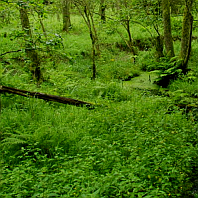27 December 2017
It is about to end a terrible year for the Galician woods. Thus, to bid farewell to 2017, nothing better than working on the regeneration of our woods.
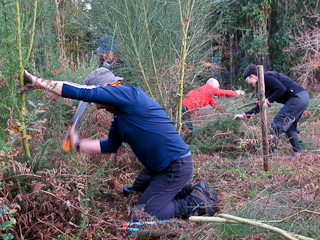 Meteorologists are announcing a short pause in the squalls, allowing a morning with smooth temperatures and partly cloudy sky. We are taking this opportunity to go up to A Espenuca, to continue the work we had started last November 19 on the 1,6 hectare plot in which we do land stewardship at the foot of the chapel. The aim is to eliminate the remaining eucalyptus trees and to clear away gorse, brooms and bramble, so that the scrub does not hinder the growth of the native trees. We will also have to clear the vegetation around the trees we had planted, because they are still very small.
Meteorologists are announcing a short pause in the squalls, allowing a morning with smooth temperatures and partly cloudy sky. We are taking this opportunity to go up to A Espenuca, to continue the work we had started last November 19 on the 1,6 hectare plot in which we do land stewardship at the foot of the chapel. The aim is to eliminate the remaining eucalyptus trees and to clear away gorse, brooms and bramble, so that the scrub does not hinder the growth of the native trees. We will also have to clear the vegetation around the trees we had planted, because they are still very small.
If you want to know in detail what we are doing at this wood, you can look up the section Fraga da Espenuca campaign on our website.
Should you like to participate, please send us your data in advance (complete name, ID, date of birth and mobile number). Thus, we will be able to inform you on last minute changes, you will be covered by an accident insurance policy and you will facilitate organization. In section Contact you will find the necessary information.
Meeting point: Outpatient Clinic of Betanzos, where we can share cars.
Date: December 30th, 2017.
Time: We will be leaving at 9.30 a.m., coming back at 2 p.m.
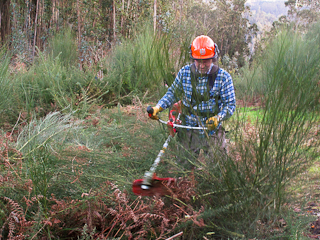 Post data: Just as forecasted by meteorologists, the twelve volunteers that got to A Espenuca enjoyed a wonderful morning. They got to complete the clearing of gorse and broom on the lower part of the plot, and uprooting some eucalyptus trees and Blackwood acacia. With this action on New Year’s Eve they showed their firm commitment to the conservation of our native woods. In early 2018 we will set a day to go on working on the rest of the plot.
Post data: Just as forecasted by meteorologists, the twelve volunteers that got to A Espenuca enjoyed a wonderful morning. They got to complete the clearing of gorse and broom on the lower part of the plot, and uprooting some eucalyptus trees and Blackwood acacia. With this action on New Year’s Eve they showed their firm commitment to the conservation of our native woods. In early 2018 we will set a day to go on working on the rest of the plot.
16 December 2017
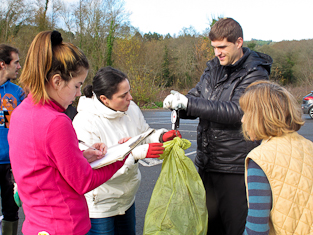 This morning we got to the protected natural heritage site SAC Encoro de Abegondo-Cecebre, as we were invited to participate in an environmental volunteering organized by the Grupo Naturalista Hábitat (Hábitat Naturalist Group).
This morning we got to the protected natural heritage site SAC Encoro de Abegondo-Cecebre, as we were invited to participate in an environmental volunteering organized by the Grupo Naturalista Hábitat (Hábitat Naturalist Group).
The selected location was the reservoir headwaters formed by the River Barcés, in the vicinity of As Táboas. Twelve volunteers quickly removed all the litter on the selected area. However, the slow and boring task was to classify it.
The aim was not to collect a great volume, but to characterize in detail the composition, origin and size of the litter, in order to provide this information to the Libera project which is being carried out by SEO/Birdlife and Ecoembes. These two organizations want to know in depth the littering phenomenon, the general dirtying due to the presence of litter everywhere, since it is severely affecting the environment.
25 November 2017
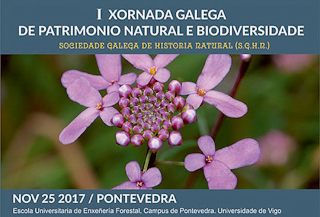 Today we have been in Pontevedra presenting the work of Fragas do Mandeo in a remarkable setting, the 1st Galician Conference on Natural Heritage and Biodiversity. It was organized by the Pontevedra’s section of the Sociedade Galega de Historia Natural (Galician Natural History Society) and took place at the University College of Forestry Engineering; it had the participation of 11 speakers who talked about plenty of topics, from forest fires to fauna monitoring software, as well as environmental information and problems caused by micro-plastics. It was a very interesting conference, attended by a large public, whose organizers are confident in its continuity.
Today we have been in Pontevedra presenting the work of Fragas do Mandeo in a remarkable setting, the 1st Galician Conference on Natural Heritage and Biodiversity. It was organized by the Pontevedra’s section of the Sociedade Galega de Historia Natural (Galician Natural History Society) and took place at the University College of Forestry Engineering; it had the participation of 11 speakers who talked about plenty of topics, from forest fires to fauna monitoring software, as well as environmental information and problems caused by micro-plastics. It was a very interesting conference, attended by a large public, whose organizers are confident in its continuity.
19 November 2017
This morning eleven volunteers visited the North slope of the A Espenuca hill to work on the 1.6 hectares plot in which we will be doing land stewardship for 50 years. Located at the foot of the chapel, it was two years ago when we started the process to transform the eucalyptus wood into a native wood.
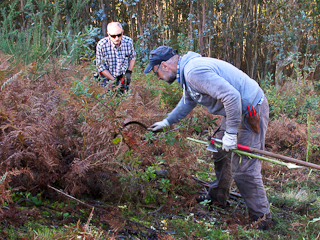 In the first half of the year we went over the elimination of the eucalyptus trees born from seed (only a few remained that had re-sprouted from stump). With the summer, the fern, gorse and broom made it difficult to locate and even to reach them. We could not clear all the scrub, as the drought makes it too easy for any spark from the weeding machine to set on fire. Nor was it advisable, since with this summer intense heat, the vegetation provides shade and damp to the trees that we had planted.
In the first half of the year we went over the elimination of the eucalyptus trees born from seed (only a few remained that had re-sprouted from stump). With the summer, the fern, gorse and broom made it difficult to locate and even to reach them. We could not clear all the scrub, as the drought makes it too easy for any spark from the weeding machine to set on fire. Nor was it advisable, since with this summer intense heat, the vegetation provides shade and damp to the trees that we had planted.
Today we took advantage of the sunny weather, grateful that the vegetation was not wet because of the dew. A volunteer completed the cleaning of the inner paths, which he had started a couple of days earlier. The rest of us were uprooting eucalyptus and cutting gorse and broom (some of them were more than two meters high).
Free from all that vegetation, the volunteers were able to find the trees we had planted and those that spontaneously grew from seed. At the beginning of the next spring the trees will grow straight without any problem. They also realized that the ground was covered by moss and low-lying vegetation, an excellent defence against erosion on such a steep slope. The improvement of the habitat can also be noticed in the fauna, since while they were working they found a salamander (Salamandra salamandra) and one common toad (Bufo spinosus).
There are still many days ahead to complete these important forestry works: Recovering a wood involves much more than simply planting trees. Should you like to participate in the next volunteering days and you are not on our mailing list yet, please contact us. In section Contact you will find detailed information.
29 October 2017
One month ago we celebrated the sixth Land Stewardship Week, during which the volunteers’ hard work produced really successful results. But it’s about time to undertake some pending tasks.
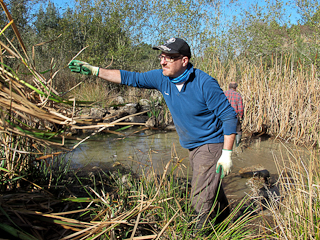 This morning ten volunteers went to work to O Catorce amphibian reserve. The main objective was to restore one of the pools. Taking advantage of the drought that lowered the water level, we were able to remove the excessive vegetation. Thus, the pool will keep part of its surface completely clear, enabling the diversity suitable to the ecological requirements of various species.
This morning ten volunteers went to work to O Catorce amphibian reserve. The main objective was to restore one of the pools. Taking advantage of the drought that lowered the water level, we were able to remove the excessive vegetation. Thus, the pool will keep part of its surface completely clear, enabling the diversity suitable to the ecological requirements of various species.
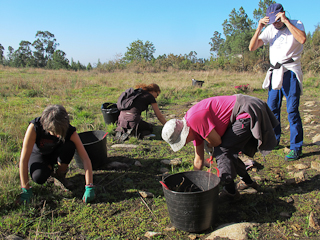 We also needed to check two exotic invasive species which weren’t eradicated yet. The volunteers eliminated the Canadian horseweed (Conyza canadensis) throughout the quarry, filling eleven 100-litre sacks. On the other hand, they were able to eliminate the tall flatsedge (Cyperus eragrostis) on the upper terrace. Depending on the evolution on that area, we will decide if it is feasible to eradicate it on the lower terrace, where it is very abundant.
We also needed to check two exotic invasive species which weren’t eradicated yet. The volunteers eliminated the Canadian horseweed (Conyza canadensis) throughout the quarry, filling eleven 100-litre sacks. On the other hand, they were able to eliminate the tall flatsedge (Cyperus eragrostis) on the upper terrace. Depending on the evolution on that area, we will decide if it is feasible to eradicate it on the lower terrace, where it is very abundant.
Finally, we cut the gorse on the West boundary with a weeding machine, as they were growing a lot, blocking the way.
12 October 2017
The sixth edition of Land Stewardship Week was a complete success, but now it’s over and nature still needs our efforts.
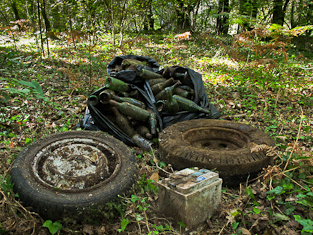 Taking advantage of today’s public holiday, one of our volunteers got to the River Mandeo to check if new exotic invasive species had reappeared on the stretch between the footbridge of Chelo and the Teixeiro Bridge, and at the same time, to remove the litter that is all too frequently thrown away on this beaten track.
Taking advantage of today’s public holiday, one of our volunteers got to the River Mandeo to check if new exotic invasive species had reappeared on the stretch between the footbridge of Chelo and the Teixeiro Bridge, and at the same time, to remove the litter that is all too frequently thrown away on this beaten track.
He located a few plants of montbretia and of small-leaf spiderwort, but looking for litter he was able to find it abundantly hidden on the wood near the path: 71 glass bottles, two tyres, one car battery and diverse types of rubbish which filled a 100-litre sack.
We all can do something for nature. If you would like to be informed on the next environmental volunteering days, please contact us. In section Contact you will find detailed information.
14 May 2017
This morning four volunteers got to the spot of Chelo (Coirós) with the aim of definitively eliminating the montbretia (Crocosmia x crocosmiiflora) and the small-leaf spiderwort (Tradescantia fluminensis).
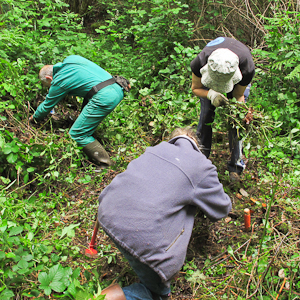 Fragas do Mandeo has been working on the eradication of invasive exotic species by the River Mandeo since 2014. On the stretch between the Chelo footbridge and the Teixeiro Bridge, besides the above mentioned species, they have eliminated the garden privet (Ligustrum ovalifolium), the blackwood acacia (Acacia melanoxylon), the Pampas grass (Cortaderia selloana), the tall flatsedge (Cyperus eragrostis), the buddleia (Buddleja davidii) and the hydrangea (Hydrangea sp.).
Fragas do Mandeo has been working on the eradication of invasive exotic species by the River Mandeo since 2014. On the stretch between the Chelo footbridge and the Teixeiro Bridge, besides the above mentioned species, they have eliminated the garden privet (Ligustrum ovalifolium), the blackwood acacia (Acacia melanoxylon), the Pampas grass (Cortaderia selloana), the tall flatsedge (Cyperus eragrostis), the buddleia (Buddleja davidii) and the hydrangea (Hydrangea sp.).
10 May 2017
The enrolment period to register for the international work camp that will take place this summer at Chelo ―at the foot of the A Espenuca hill― is already open.
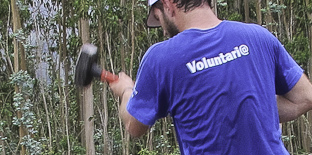 Between August 1st and 12th, fifteen volunteers are going to collaborate with us in the elimination of invasive exotic species in the surroundings of the River Mandeo. As a result of a three years ’ work, we have almost eliminated the invasive plants on both banks of the river along the stretch between the Chelo footbridge and the Teixeiro Bridge. Unfortunately, there are several fonts of montbretia (Crocosmia x crocosmiiflora) and of small-leaf spiderwort (Tradescantia fluminensis) along the As Bouzas spring, which flows into the River Mandeo by the Chelo footbridge. Propagule can be swept along by the river floods and they can take root on any spot of the riverbanks where they had been eliminated. For this reason the volunteers’ cooperation with this second international work camp is so important.
Between August 1st and 12th, fifteen volunteers are going to collaborate with us in the elimination of invasive exotic species in the surroundings of the River Mandeo. As a result of a three years ’ work, we have almost eliminated the invasive plants on both banks of the river along the stretch between the Chelo footbridge and the Teixeiro Bridge. Unfortunately, there are several fonts of montbretia (Crocosmia x crocosmiiflora) and of small-leaf spiderwort (Tradescantia fluminensis) along the As Bouzas spring, which flows into the River Mandeo by the Chelo footbridge. Propagule can be swept along by the river floods and they can take root on any spot of the riverbanks where they had been eliminated. For this reason the volunteers’ cooperation with this second international work camp is so important.
The work will consist mainly of patiently uprooting the montbretia tubers, trying not to leave any. As for the small-leaf spiderwort, uprooting its fragile stems without leaving any piece behind is enough, since any piece can easily take root. But it’s not all about working, the programme includes cultural and touristic activities which will allow the volunteers to get to know our area. It is aimed at people from 18 to 30 years old, with some vacancies for people coming from abroad and from other Spanish autonomous regions.
Work camps are informal educational tools that cover both participation and volunteering experiences. They promote the involvement of young people in society, allow exchanges between territories and seek to promote the values of coexistence, tolerance and teamwork.
This work camp is promoted by Fragas do Mandeo, applied for by the Coirós Council and organized by the Directorate General for Youth, Participation and Volunteering of the Xunta de Galicia. The management will be assumed by Ribeirán Proxectos Naturais, counting on Jesús Díaz as Director.
For additional information and registration, please consult the card of the Monte de A Espenuca 2017 work camp .
1 May 2017
After this spring’s long drought, on the 23rd thirteen volunteers got to the Ollo da Roda reserve (Oza-Cesuras), trusting the weather forecasts of the long-awaited rains on Wednesday. We couldn’t have imagined that the risk was not the lack of water: after the rains, a strong frost fell on Thursday, harming both the surrounding vegetation and the trees we had planted. Fortunately, it rained again yesterday and they seem to be recovering. Work in nature always involves the unexpected.
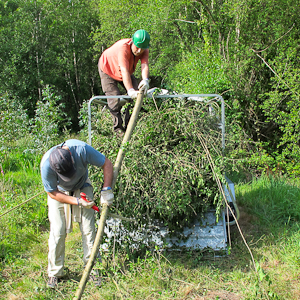 Last Saturday a couple of volunteers went to remove litter along the coastal stretch between the A Ribeira and Alameda beaches (Miño), within the protected natural area SAC Betanzos-Mandeo. They filled two sacks of debris and removed several ropes of bateas (mussel culture rafts). They also checked if any Pampas grass (Cortaderia selloana) had reappeared in the Alameda Beach, finding only four small specimens, which were eliminated.
Last Saturday a couple of volunteers went to remove litter along the coastal stretch between the A Ribeira and Alameda beaches (Miño), within the protected natural area SAC Betanzos-Mandeo. They filled two sacks of debris and removed several ropes of bateas (mussel culture rafts). They also checked if any Pampas grass (Cortaderia selloana) had reappeared in the Alameda Beach, finding only four small specimens, which were eliminated.
Today nine people have done environmental volunteering again at Ollo da Roda. On the previous occasion, what with planting and removing litter, there was no time left to eliminate the garden privets (Ligustrum ovalifolium). As spring progresses and the vegetation grows up hiding these bushes and closing in the paths, it became urgent to finish off the work.
So the objective was clear: uproot every one we could find. The volunteers needed a whole morning to achieve it. In the afternoon two volunteers filled a garden trailer to the brim with the uprooted waste in order to take them to a treatment point, and there was still foliage to fill another trailer; in total there were 9 cubic metres.
Thanks to such effective volunteering, the creation of the Ollo da Roda reserve is advancing at a good pace.
17 April 2017
Next Sunday, April 23rd, we will get to the River Mendo in order to work on the reserve we are creating in Ollo da Roda. The spring draws on and we have to take advantage of good weather.
The objective is to eliminate the garden privet (Ligustrum ovalifolium), which we were not able to find last year due to the vegetation height, and some specimens of robinia (Robinia pseudoacacia). At the same time, we will check if any eucalyptus has produced new shoots or has sprouted from seed, and we will remove any litter we can find. Finally, we will plant some donated native trees.
The meeting point will be the Outpatient Clinic of Betanzos, where we will share cars. You don’t need to take any tools, but try to take leather gloves, wear clothes and shoes suitable to work on the woods, and don’t forget something to eat and drink for the mid-morning break.
If you are interested in actively preserve biodiversity, please register for this environmental volunteering day by sending us your data in advance (complete name, ID card, birth date and mobile phone number). Thus, you will be informed on last minute changes, you will be covered by an accident insurance policy and you will facilitate organization. In section Contact you will find the necessary information.
Meeting point: Outpatient Clinic of Betanzos.
Date: April 23rd, 2017.
Time: We will be leaving at 9.30 a.m., coming back at 2 p.m.
 Meteorologists are announcing a short pause in the squalls, allowing a morning with smooth temperatures and partly cloudy sky. We are taking this opportunity to go up to A Espenuca, to continue the work we had started last November 19 on the 1,6 hectare plot in which we do land stewardship at the foot of the chapel. The aim is to eliminate the remaining eucalyptus trees and to clear away gorse, brooms and bramble, so that the scrub does not hinder the growth of the native trees. We will also have to clear the vegetation around the trees we had planted, because they are still very small.
Meteorologists are announcing a short pause in the squalls, allowing a morning with smooth temperatures and partly cloudy sky. We are taking this opportunity to go up to A Espenuca, to continue the work we had started last November 19 on the 1,6 hectare plot in which we do land stewardship at the foot of the chapel. The aim is to eliminate the remaining eucalyptus trees and to clear away gorse, brooms and bramble, so that the scrub does not hinder the growth of the native trees. We will also have to clear the vegetation around the trees we had planted, because they are still very small. Post data: Just as forecasted by meteorologists, the twelve volunteers that got to A Espenuca enjoyed a wonderful morning. They got to complete the clearing of gorse and broom on the lower part of the plot, and uprooting some eucalyptus trees and Blackwood acacia. With this action on New Year’s Eve they showed their firm commitment to the conservation of our native woods. In early 2018 we will set a day to go on working on the rest of the plot.
Post data: Just as forecasted by meteorologists, the twelve volunteers that got to A Espenuca enjoyed a wonderful morning. They got to complete the clearing of gorse and broom on the lower part of the plot, and uprooting some eucalyptus trees and Blackwood acacia. With this action on New Year’s Eve they showed their firm commitment to the conservation of our native woods. In early 2018 we will set a day to go on working on the rest of the plot. This morning we got to the protected natural heritage site SAC Encoro de Abegondo-Cecebre, as we were invited to participate in an environmental volunteering organized by the
This morning we got to the protected natural heritage site SAC Encoro de Abegondo-Cecebre, as we were invited to participate in an environmental volunteering organized by the  Today we have been in Pontevedra presenting the work of Fragas do Mandeo in a remarkable setting, the 1st Galician Conference on Natural Heritage and Biodiversity. It was organized by the Pontevedra’s section of the
Today we have been in Pontevedra presenting the work of Fragas do Mandeo in a remarkable setting, the 1st Galician Conference on Natural Heritage and Biodiversity. It was organized by the Pontevedra’s section of the  In the first half of the year we went over the elimination of the eucalyptus trees born from seed (only a few remained that had re-sprouted from stump). With the summer, the fern, gorse and broom made it difficult to locate and even to reach them. We could not clear all the scrub, as the drought makes it too easy for any spark from the weeding machine to set on fire. Nor was it advisable, since with this summer intense heat, the vegetation provides shade and damp to the trees that we had planted.
In the first half of the year we went over the elimination of the eucalyptus trees born from seed (only a few remained that had re-sprouted from stump). With the summer, the fern, gorse and broom made it difficult to locate and even to reach them. We could not clear all the scrub, as the drought makes it too easy for any spark from the weeding machine to set on fire. Nor was it advisable, since with this summer intense heat, the vegetation provides shade and damp to the trees that we had planted.  This morning ten volunteers went to work to O Catorce amphibian reserve. The main objective was to restore one of the pools. Taking advantage of the drought that lowered the water level, we were able to remove the excessive vegetation. Thus, the pool will keep part of its surface completely clear, enabling the diversity suitable to the ecological requirements of various species.
This morning ten volunteers went to work to O Catorce amphibian reserve. The main objective was to restore one of the pools. Taking advantage of the drought that lowered the water level, we were able to remove the excessive vegetation. Thus, the pool will keep part of its surface completely clear, enabling the diversity suitable to the ecological requirements of various species. We also needed to check two exotic invasive species which weren’t eradicated yet. The volunteers eliminated the
We also needed to check two exotic invasive species which weren’t eradicated yet. The volunteers eliminated the  Taking advantage of today’s public holiday, one of our volunteers got to the River Mandeo to check if new exotic invasive species had reappeared on the stretch between the footbridge of Chelo and the Teixeiro Bridge, and at the same time, to remove the litter that is all too frequently thrown away on this beaten track.
Taking advantage of today’s public holiday, one of our volunteers got to the River Mandeo to check if new exotic invasive species had reappeared on the stretch between the footbridge of Chelo and the Teixeiro Bridge, and at the same time, to remove the litter that is all too frequently thrown away on this beaten track. Fragas do Mandeo has been working on the eradication of invasive exotic species by the River Mandeo since 2014. On the stretch between the Chelo footbridge and the Teixeiro Bridge, besides the above mentioned species, they have eliminated the
Fragas do Mandeo has been working on the eradication of invasive exotic species by the River Mandeo since 2014. On the stretch between the Chelo footbridge and the Teixeiro Bridge, besides the above mentioned species, they have eliminated the  Between August 1st and 12th, fifteen volunteers are going to collaborate with us in the elimination of invasive exotic species in the surroundings of the River Mandeo. As a result of
Between August 1st and 12th, fifteen volunteers are going to collaborate with us in the elimination of invasive exotic species in the surroundings of the River Mandeo. As a result of  Last Saturday a couple of volunteers went to remove litter along the coastal stretch between the A Ribeira and Alameda beaches (Miño), within the protected natural area SAC Betanzos-Mandeo. They filled two sacks of debris and removed several ropes of bateas (mussel culture rafts). They also checked if any
Last Saturday a couple of volunteers went to remove litter along the coastal stretch between the A Ribeira and Alameda beaches (Miño), within the protected natural area SAC Betanzos-Mandeo. They filled two sacks of debris and removed several ropes of bateas (mussel culture rafts). They also checked if any 
